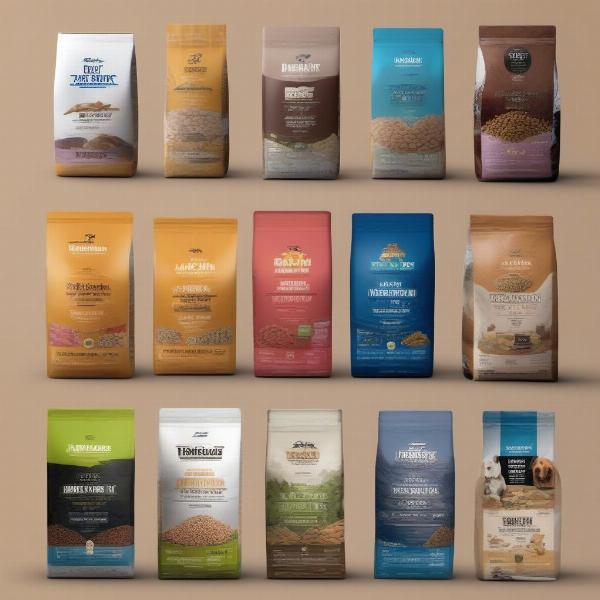Finding the right dry dog food can be challenging, especially when you’re looking for a protein-rich option. A high-protein diet can be beneficial for active dogs, growing puppies, and even senior dogs maintaining muscle mass. This guide explores everything you need to know about dry dog food with the most protein, helping you make an informed choice for your canine companion.
Understanding Protein in Dog Food
Why is protein so important for dogs? Protein provides the building blocks for strong muscles, healthy skin and coat, and a robust immune system. It also contributes to energy levels and overall well-being. Choosing a dry dog food with adequate protein is crucial for your dog’s health and vitality. But what constitutes “adequate”? This varies depending on your dog’s age, breed, activity level, and overall health.
While focusing on protein content is important, it’s equally vital to consider the source of protein. Look for dog foods that list specific meat sources, such as chicken, beef, lamb, or fish, as the primary ingredients. Avoid generic terms like “meat by-products” or “animal meal,” as these can be lower quality and less digestible.
How Much Protein Does My Dog Need?
The Association of American Feed Control Officials (AAFCO) recommends a minimum of 18% protein for adult dog maintenance and 22% for growth and reproduction (puppies and pregnant/lactating dogs). However, many active dogs or those with specific dietary needs may benefit from even higher protein levels.
Choosing the Right High-Protein Dry Dog Food
When selecting a high-protein dry dog food, consider the following factors:
- Life Stage: Puppies, adults, and seniors have different protein requirements.
- Activity Level: Active dogs need more protein than less active dogs.
- Breed: Certain breeds may have specific dietary needs.
- Ingredients: Look for whole meat sources and avoid fillers.
- AAFCO Statement: Ensure the food meets AAFCO standards.
Remember, choosing a high-protein dog food isn’t solely about finding the highest percentage. It’s about finding a balanced formula with high-quality protein sources that meets your dog’s individual needs. dog food with most meat content Always consult with your veterinarian before making significant changes to your dog’s diet, especially if they have any underlying health conditions.
Common Misconceptions about High-Protein Dog Food
Some pet owners worry that high-protein diets can harm their dogs. However, for most healthy dogs, a high-protein diet is not harmful and can even be beneficial. One common misconception is that high protein causes kidney problems. This is generally untrue unless the dog already has pre-existing kidney disease. is blue a good dog food
 Comparing High-Protein Dog Foods
Comparing High-Protein Dog Foods
“High protein diets can be a great option for many dogs,” says Dr. Emily Carter, DVM. “However, it’s crucial to work with your veterinarian to determine the right protein level and formula for your dog’s specific needs.” Another expert, canine nutritionist Sarah Miller, adds, “Focusing on the quality of the protein source is just as important as the quantity. Look for whole meat sources and avoid fillers.”
Conclusion
Choosing a dry dog food with the most protein involves careful consideration of your dog’s individual needs. By understanding the importance of protein, knowing how much your dog requires, and selecting a high-quality formula, you can ensure your furry friend receives the optimal nutrition they need to thrive. valens dog food Remember to consult with your veterinarian for personalized guidance.
FAQ
- Is a high-protein diet good for all dogs? Not necessarily. While generally safe for healthy dogs, it’s important to consult with your veterinarian to determine the right protein level for your dog’s individual needs.
- Can too much protein harm my dog? For most healthy dogs, a high-protein diet is not harmful. However, excessive protein can be problematic for dogs with pre-existing kidney issues.
- What are some signs of protein deficiency in dogs? Signs can include weight loss, muscle atrophy, dull coat, and weakened immune system.
- How do I transition my dog to a high-protein diet? Gradually introduce the new food over several days to avoid digestive upset.
- Are grain-free high-protein diets better? Not necessarily. Grain-free diets are not inherently better than those containing grains. The focus should be on the quality of ingredients and overall nutritional balance.
- What are some good sources of protein in dog food? Chicken, beef, lamb, fish, eggs, and lentils are all good sources of protein. dog food for senior dogs with bad teeth
- How can I tell if my dog is getting enough protein? Monitor your dog’s weight, muscle mass, coat condition, and overall energy levels. Consult with your veterinarian if you have any concerns.
ILM Dog is your trusted resource for all things dog-related. We offer expert advice on dog breeds, health, training, nutrition, grooming, and much more. Whether you’re a seasoned dog owner or just starting out, ILM Dog provides valuable insights and practical tips to help you care for your canine companion. iga dog food From choosing the right food to understanding your dog’s behavior, we’re here to support you every step of the way. Contact us today at [email protected] or +44 20-3965-8624 for personalized guidance and support.